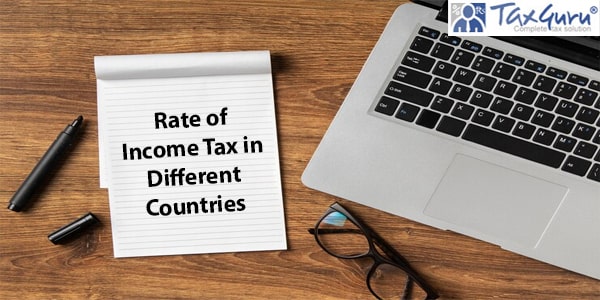Introduction: The realm of income tax rates across different nations offers a fascinating landscape, ranging from countries with zero income tax to those levying substantial percentages. As Finance Minister Smt. Nirmala Sitaraman unveils the latest budget, it’s a poignant moment to reflect on India’s tax regime amidst global counterparts.
On 1st of February, 2024, Finance Minister Smt. Niramla Sitaraman, published her 6th Budget i.e. Interim Union Budget 2024-25 in Parliament. Before that other finance ministers have published more than 6 budget, are
|
Moraraji Desai |
11 |
| P. Chidambaram | 09 |
| Pranav Mukharji and Yashvant Sinha (each) | 08 |
Though this was Vote on account, but expectation of people was there should be deduction in tax rate, change tax slab etc. As this was the last budget of present government and election will be in May or June. People are little bit displeased with finance minister.
If you will look at the rate of income tax in other country, will surprise and believe that India is the country where income tax rate is law.
In U.S.A. there are seven slabs of Income Tax. In first slab, if you earn 11,000 dolor, you have to pay 10% income tax. Highest slab of tax at USA is 37% against 30% in India.
In UK exemption limit of income is 12,570 pounds then 20% tax is livable. After that National Insurance Surcharge at the rate of 60% which make rate of tax 32%. Maximum rate of income tax is 40% plus National Insurance Surcharge, which make rate of tax 64%. It seem that UK is the country where highest rate of income tax is chargeable.
In Europe rate of income tax is above 40%, while in Japan it is 60% and in China 45%.
Against these rate of income tax in different countries, there are number of countries where the rate of personal income tax is ZERO. There are 59 different countries, where no income tax is payable. The question may arise in our mind how they provide facilities to the people of their country. The answer is simple, most of these type of countries population is less and area of country is very small. The people are very poor, while other countries are very rich that they do not need to collect tax.

The countries like Saudi Arabia, UAE, Katar, Bahrain, Oman, Kuwait there is no Income Tax. The economy of these countries is based on business of Fruide oil, and attract to people outside country, there is no income tax. Over and above these, there are other so many countries where there is no income tax. Like Bahamas, Bermuda, Myanmar, Liberia, New Ginia, Iceland, Sudan, etc.
The reason for not laying income tax is different for different countries, like develop business activates and strong financial position to get employment to the people of country, while people of some country are very poor.
At present highest rate of income tax is in Ivory Cost a country of Western Africa, which is not rich country, but rate of income tax is 60%. Finland of Europe is also charging income tax at 56.75%, while in Denmark rate of income tax is 56% and in Australia 50%. Even in Sweden, Belgium, Israel, Netherland and other few countries rate of Income tax is 50% and above.
Let’s us talk about our country and income tax. During the year 1949-50 Mr. John Mathai was the finance minister, the rate of income tax on income of Rs.10,000 it was 97.75%, that means if you earn Rs.10,000 pay tax of Rs. 9,800 and keep Rs. 200 with you. During 1960 that means decade two times rate was reduced from 98.75 to 88.15% and from 88.25% to 81.25%. During 1974-75 when Yaswant Chauhan was finance minister, has reduced rate to 75%. At that time exemption limit of tax was income of Rs.6,000 and there were 11 tax slabs.
The highest rate of tax was reduced by government of Rajiv Gandhi, when Vishvanath Prathapsinh was finance minister. From 11 tax slabs it was reduced to only 4 slabs and highest tax slab was 50% of tax.
During 1991 to 1996, when Dr. Manmohansinh was finance minister reduced the tax slabs from 4 to 3, i.e. 20%, 30% and 40%.
When I. K. Gujaral was Prime Minister, during 1997-98, finance minister was P. Chidambaram has given a dream budget, where in rate of income tax was reduced to 30% and exemption limit was Rs. 1,50,000. There after none of the finance minister has reduced maximum rate of 30%. That means since last 27 years highest rate of income tax in our country remain the same 30%. Of course, many a times slabs were change, exemption limits were increase.
Some time, people suggest that after introduction of Goods and Service Tax (GST), the income of government is increased, therefore income tax may me abolish. This is not fair at all. Income tax should be there. One idea is that income tax on individual can be abolish and against which a Goods Consumption Tax (GCT) and Bank Transection Tax (BTT) can be introduce. Good Consumption Tax means the person who use goods or services they have to pay tax on that only. The rate of tax may be higher than Goods and Service Tax.
According to economist, Bank Transection Tax can be 1% only, then collection of tax may be high. If you withdraw money from ATM or bank, you have to pay tax. If Bank Transection Tax will apply tax evasion will reduce.
Conclusion: The analysis of income tax rates across the globe underscores the intricate interplay between fiscal policies, economic paradigms, and societal aspirations. As India embarks on yet another fiscal year, the discourse on tax reform resonates with the quest for equitable prosperity and sustainable development.





